
Coatesville is a city in Chester County, Pennsylvania, United States. The population was 13,100 at the 2010 census. Coatesville is approximately 39 miles west of Philadelphia. It developed along Lancaster Turnpike, beginning in the late 18th century. It spans U.S. Route 30, the "Main Line" highway that runs west of Philadelphia.

The Lukens Historic District encompasses four properties in Coatesville, Pennsylvania associated with the 19th and early 20th-century history of the Lukens Steel Company and the family of Rebecca Lukens (1794–1854). Lukens was the first woman to head a major industrial firm in the United States, and played a leading role in the development of the American steel industry. The district was designated a National Historic Landmark District in 1994.
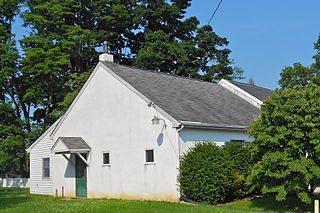
Ercildoun, population about 100, is an unincorporated community in East Fallowfield Township, Chester County, Pennsylvania, United States. The hamlet was founded by Quakers and was an early center of the abolitionist movement. In 1985 the entire hamlet, including 31 properties, was listed as a historic district on the National Register of Historic Places. Of these properties two were vacant land, 14 were significant buildings, ten were contributing buildings, and five buildings, built in the 1950s, were non-contributing. The Lukens Pierce House, an octagon house listed separately on the U.S. National Register of Historic Places, is located about half a mile northwest of the hamlet. Ercildoun is one of about ten hamlets in the township, which has no cities or towns, but has 31 sites listed on the National Register. It is one of the larger hamlets, located near the center of the township, and historically among the best known. The city of Coatesville is about 3 miles north.

Caln Meeting House is a historic Quaker meeting house located at 901 Caln Meeting House Road, near Coatesville in Caln Township, Chester County, Pennsylvania. It was built in 1726, and is a one-story, tan fieldstone structure. It was enlarged to its present size in 1801.

St. Malachi Church is a historic Irish Roman Catholic mission church on St. Malachi Road in rural Londonderry Township, Chester County, Pennsylvania. It is a mission of Our Lady of Consolation of Parkesburg. The church with its adjoining cemetery was added to the National Register of Historic Places (NRHP) in 1985.
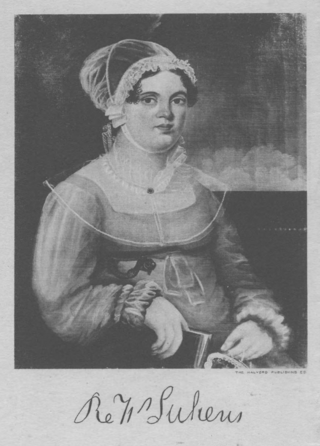
Rebecca Lukens (1794–1854), born Rebecca Webb Pennock, was an American businesswoman. She was the owner and manager of the iron and steel mill which became the Lukens Steel Company of Coatesville, Pennsylvania. Fortune Magazine called her "America's first female CEO of an industrial company" and its board of editors named her to the National Business Hall of Fame in 1994.
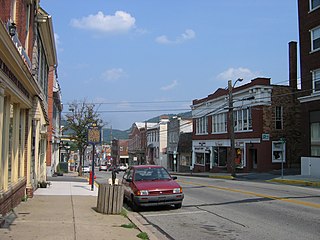
Bedford Historic District is a national historic district located at Bedford, Bedford County, Pennsylvania. The district includes 210 contributing buildings in the central business district and surrounding residential areas of Bedford. The buildings date between 1750 and 1930, and include notable examples of Greek Revival, Italianate, and Federal style architecture. Notable non-residential buildings include the Fort Bedford Museum (1750s), Neptune House, G. C. Murphy Company Building, Arnold Building, Victoria House (1876), Bedford Cafe, Talvin Lodge (1880), Penn Bedford Hotel (1922), Ford Garage (1922), and St. Thomas the Apostle Church. Located in the district and listed separately are the Barclay House, Espy House, Russell House, and Chalybeate Springs Hotel.
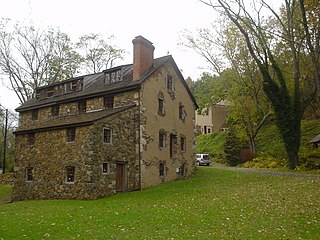
Chester Creek Historic District is a national historic district located along the west branch of Chester Creek at Thornbury Township, Delaware County, Pennsylvania. The district includes 52 contributing buildings and 5 structures associated with the early settlement and industrial development of the Chester Creek valley. Notable buildings and structures include the Yarnall Bank House, Locksley Mill and Manor House (1704), John Edwards House, Glen Mills Station (1882), Station House and Store, Willcox Mills, Workers' Cottages, Daniel Broomall House, and the Hemphill House.

Goshenville Historic District is a national historic district located in East Goshen Township, Chester County, Pennsylvania. It encompasses 11 contributing buildings, 2 contributing sites, and 2 contributing structures in the crossroads village of Goshenville. They date to the 18th and 19th century, and are reflective of a number of popular architectural styles including Greek Revival. They include residences, farmhouses, a tenant house, Goshen Friends Meetinghouse (1849) and burial ground, Hicksite Meetinghouse (1855) and burial ground, a general store and post office (1800), and a blacksmith / wheelwright shop.

West Chester Downtown Historic District is a national historic district located in West Chester, Chester County, Pennsylvania. It encompasses 3,137 contributing buildings in West Chester. It includes residential, commercial, institutional, and industrial buildings built between 1789 and the 1930s. Notable buildings include the U.S. Post Office, Green Tree Building (1933), St. Agnes Church (1851), Biddle Street School (1917), Major Groff Memorial Armory, Horticulture Building (1848) designed by Thomas U. Walter, Denney-Reyburn factory, Caleb Taylor Store, Federal Ehne's Bakery, Kofke's Store, and Woolworth (1928). Also listed and located in the district are the Bank of Chester County, Buckwalter Building, Chester County Courthouse, Farmers and Mechanics Building, and Warner Theater.

Clement Atkinson Memorial Hospital is a historic hospital building located at Coatesville, Chester County, Pennsylvania. It is a building in five sections. The original section was the home of Dr. Atkinson, and is a 2+1⁄2-story, three-bay brick rowhouse dwelling in the Colonial Revival style. It and a one-story, eight-room, hospital wing at the rear of the dwelling, were built in 1932. A second story was added to the hospital wing in 1937. Later additions took place in 1955, 1962, and 1969. The hospital was converted to a community center and low-income apartments in 1991. The hospital served the local African American population and remained in operation until 1977.

Lukens Main Office Building is a historic office building located at Coatesville, Chester County, Pennsylvania, USA. The original section was designed by the architectural firm of Cope & Stewardson and built in 1902, for the Lukens Steel Company. It is a 2½-story, seven bay, brick "T"-shaped building in a Colonial Revival / Georgian Revival style. It has a hipped roof with dormers and flanking two-story, three bay wings. A duplicate of the original structure was added to it in 1916, making it an "H"-shaped building. The addition was designed by the successor firm of Page & Stewardson. Today the building is home to the National Iron & Steel Heritage Museum and other local businesses and organizations.
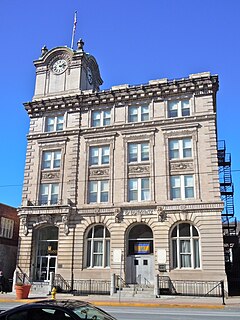
National Bank of Coatesville Building, also known as the Industrial Valley Bank Building, is a historic bank building located at Coatesville, Chester County, Pennsylvania. It was built between 1906 and 1908, and is a four-story, steel-frame structure faced in buff-colored brick and Indiana Limestone in an eclectic Late Victorian style. It measures 70 feet by 140 feet, and is trimmed in terra cotta and Indiana limestone. It features a clock tower with rounded dome framing. In addition to the bank, the building once housed the post office. The building has been converted to apartments.

Terracina, also known as The Huston House, is a historic home located at Coatesville, Chester County, Pennsylvania. It was built in 1848, and is a 2+1⁄2-story, stuccoed stone dwelling with a steeply pitched roof in the Gothic Revival style. It has a two-story, flat-roofed rear wing. It features a full-width, hipped-roof front porch. The house was built as a wedding present by Rebecca Lukens for her daughter Isabella upon her marriage to Dr. Charles Huston.

Abram Huston House and Carriage House, also known as the Coatesville City Hall and Police Station and "Graystone Mansion," is a historic building located at Coatesville, Chester County, Pennsylvania. It was designed and built in 1889, by the architectural firm of Cope & Stewardson. The house is a 2+1⁄2-story building, built of shaped coursed stone, irregularly shaped in plan, and has a two-story wing added in 1925. The carriage house is "L" shaped, and features a two-story tower with a conical roof. The house was built as the home of Abram Huston, president of the Lukens Steel Company. The house was Coatesville City Hall and the carriage house was the Coatesville jail from 1939 to 1992.

Springton Manor Farm is a historic farm and national historic district located in Wallace Township, Chester County, Pennsylvania. The farm has 14 contributing buildings, 1 contributing site, and 5 contributing structures. They include the main house, a cistern, tool shed, privy, spring and milk house, carriage house, small barn, corn crib, bank barn, stone lean-to, the ruins of a stone spring house, and hydraulic dams. The main house is in three sections; the earliest dates about 1836, with additions and modifications made in 1887 and 1912. It is a 2 1/2-story, seven bay by two bay, stuccoed stone dwelling with Georgian and Queen Anne style design details. Originally built by Joseph Muckleduff in the early 1700s. Upon Joseph's death 9 Sep 1750, Springton Manor was left to his brother Samuel Muckleduff. [Chester Co PA Wills & Mention in Wills 1713 - 1825]. It was the home of Congressman Abraham Robinson McIlvaine (1804-1863). The property is administered as a park and agricultural history museum by Chester County.
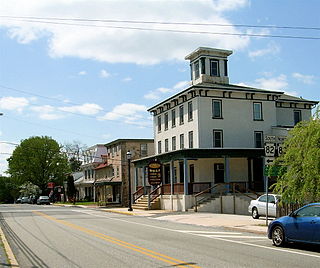
Elverson Historic District is a national historic district located in Elverson, Chester County, Pennsylvania. The district includes 133 contributing buildings, 3 contributing sites, and 4 contributing structures in the central business district and surrounding residential areas of Elverson. The district includes a variety of residential, commercial, and institutional buildings with examples of Bungalow/craftsman, Georgian, and Gothic Revival architecture. Contributing buildings date from about 1750 to about 1930. Notable buildings include "The Bank House", train station (1870), Springfield M.E. Church (1869), Blue Rock Hotel (1860), Dengler Bro. Store, Whoye Horse Tavern (1811), The Creamery (1906), and Springfield School (1873). One of the contributing structures is the railroad car "Baltimore County."
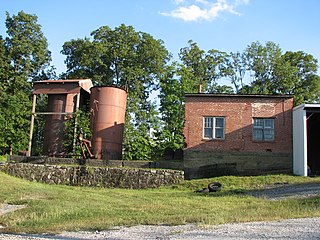
Byers Station Historic District is a national historic district located in Upper Uwchlan Township, Chester County, Pennsylvania. The district includes 26 contributing buildings in the crossroads community of Byers Station. The buildings date to the 19th century and include a number of notable Italianate style buildings. Notable buildings include a variety of residences, a factory, a Masonic lodge (1894), and the former Byers Hotel. The community grew around the Byers railroad station, after its opening in 1871, and continued after plumbago (graphite) was discovered in the area in 1875.
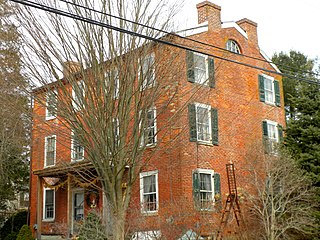
Unionville Village Historic District is a national historic district located at Unionville in East Marlborough Township, Chester County, Pennsylvania. It encompasses 69 contributing buildings in the village of Unionville. It includes a variety of brick, stone, and frame residences the earliest of which is dated to about 1750. Notable buildings include Unionville Academy (1834), country store, Union Hotel (1834), Cross Keys Inn (1751), Unionville Saddle Shop (1887), Unionville Hall (1849–50), Grange Hall, and Green Lawn Seminary.
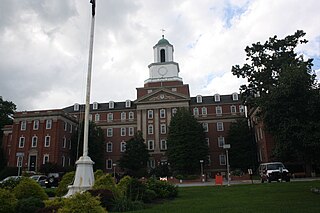
The Coatesville Veterans Administration Hospital Historic District, in or near Coatesville, Pennsylvania, was built in 1929. It was listed on the National Register of Historic Places in 2013. The listing included 37 contributing buildings, four contributing structures, a contributing object and two contributing sites.























